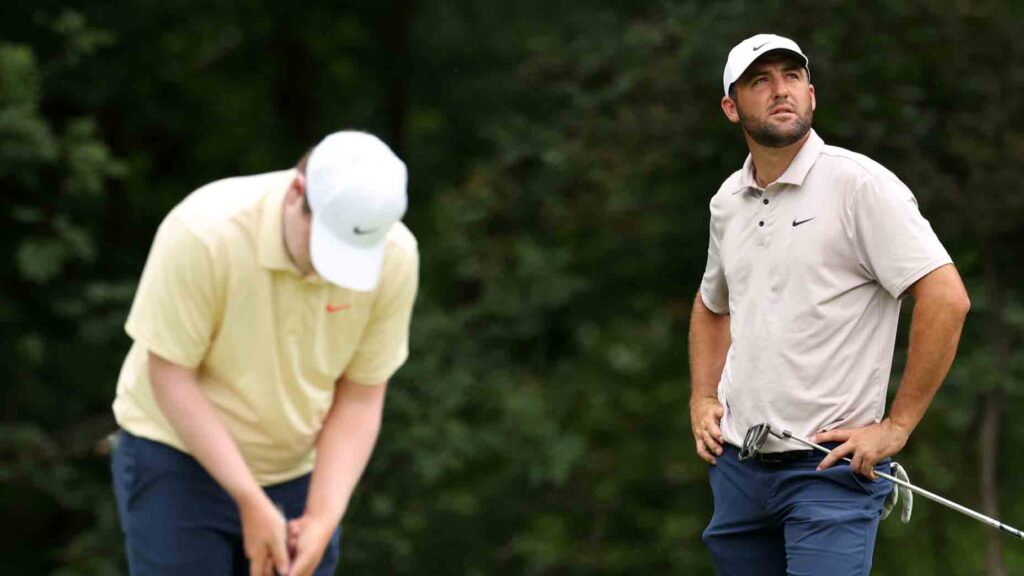The Pace of Play Controversy at Caves Valley: Insights from Scottie Scheffler
In the high-stakes world of professional golf, how one manages time on the course can significantly impact performance and morale. During the third round of the recent BMW Championship at Caves Valley, top-ranked golfer Scottie Scheffler shared his frustrations regarding pace of play, an ongoing issue in professional tournaments. As he navigated the course, the pressure of timing weighed heavily on him, leading to questions about the system in place to ensure smooth play.
Scheffler’s day started with high expectations but soon turned into a bewildering experience as he hustled to maintain pace on the greens. "We somehow didn’t gain a single second on pace of play," Scheffler stated incredulously after his round. Despite his efforts to stay on track, something felt amiss—a sentiment shared by many players on the tour. This has raised questions about the effectiveness of pace-of-play regulations and their enforcement.
On the 9th hole, both Scheffler and his playing partner, Robert MacIntyre, received warnings for falling behind the established pace. The tension in the air was palpable as Scheffler expressed his confusion: "I didn’t really feel like I did anything to put us behind on time." Many golf fans echoed his sentiments, wondering why some players felt unjustly scrutinized while others appeared unaffected by similar slowdowns.
Pace of play has always been a topic of discussion, yet this year, it has garnered heightened attention—from players and fans alike. The PGA Tour recently introduced various changes in an attempt to address these concerns, including potential naming and shaming tactics. Such measures have sparked debates within the golfing community about fairness and the psychological toll of being constantly monitored.
As Scheffler proceeded through the 10th and 11th holes, he continued to grapple with the pressure of timing. Even maintaining a solid performance—he finished with a three-under 67—did little to alleviate his frustrations. Fellow competitor Ludvig Aberg, known for his quick pace, also found himself on the clock that day, illustrating the complex dynamics at play regarding timing under tournament conditions.
The growing trend of tracking pace with live television graphics has allowed spectators to see real-time updates on group performances, adding another layer of scrutiny. During the coverage, fans witnessed the group of Patrick Cantlay and Shane Lowry being warned on the 13th hole for their timing issues, further amplifying the narrative around pace of play. Mark Dusbabek, a PGA Tour rules official, noted that this group had been lagging significantly, underscoring a frustrating reality for all involved.
One major concern is how external factors can affect pace. On the day of Scheffler’s frustrations, the combinations of slower groups and weather conditions played a role in the timelines. "They’ve continually lost time along the way," Dusbabek explained, emphasizing the domino effect caused by backward-moving groups. Such circumstances often lead to players feeling penalized for delays beyond their control.
Looking forward, both players and officials are aware that something must change in the way pace of play is enforced. Scheffler himself hopes to escape similar situations in future rounds, wishing for streamlined communication and more consistent enforcement of rules. “Overall I did what I could to keep us on pace,” he stated, revealing the mental strain on professional athletes as they juggle competition and the constant pressure of timing.
The narrative is more than just individual performance; it speaks to the integrity of the sport. As discussions about pace of play intensify, stakeholders in golf must balance upholding traditions with modern expectations. It poses a unique challenge: how can the essence of the game be preserved while also embracing the demands of today’s faster-paced world?
In summary, Schaffler’s experience at the BMW Championship highlights existing discrepancies in how pace of play is managed on the PGA Tour. As the sport continues to grow, it’s imperative for governing bodies to reevaluate their regulations, ensuring fairness for all players involved. For golf enthusiasts, the debate surrounding pace of play will remain a topic of interest, and they await further developments that can enhance the experience for players and fans alike on the greens.


